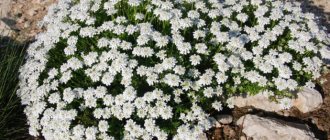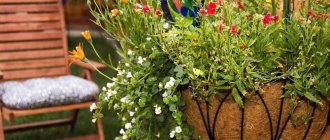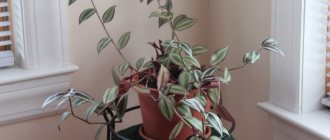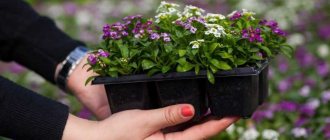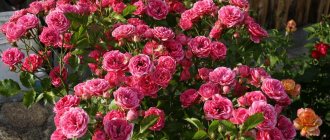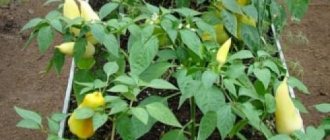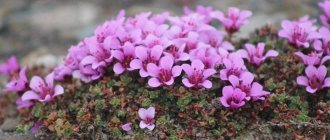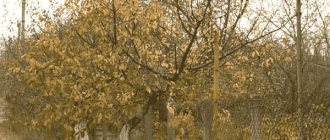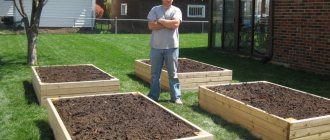Planting in a flowerbed
This is the easiest way to “install” bulbous crops in the garden, which need to be dug up annually. First of all, these are hyacinths and tulips (representatives of the groups Fringed, Liliaceae, Parrotaceae, Green-flowered, Early Terry and Late Terry). Usually in such plantings they are combined with early flowering biennials: daisies, forget-me-nots, pansies, horned violet.
Planting in a flower bed is the easiest way to add bulbs to the garden, which need to be dug up annually.
Important : after the bulbs have faded and their leaves have dried, the plants are dug up for storage, and flowering annuals .
Types of flower beds
Regardless of the design idea, a flower bed in a country house is a piece of land for planting flowers. Based on the types of plants planted, flower beds and flower beds are conventionally divided into:
- Simple single-level (carpet). All plants are the same height, and their pattern creates a floral carpet on the ground. A special feature of caring for such a flower bed is its regular cutting to even out the composition;
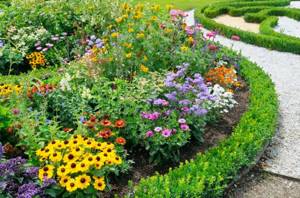
- Multi-level flower paintings. This type of flower bed combines annual and perennial plants of different types and sizes. The difficulty of creating such a flower bed near the house with your own hands lies in the correct selection of plants and flower arrangements;
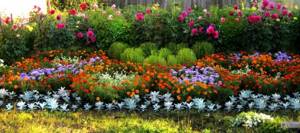
- Flowerbeds in the country, which are placed on the walls of a private house. An interesting design idea is flower pots or less original beautiful stems climbing along the walls that can be planted in front of the house in the yard.

Depending on the shape and type of composition, flower beds at the dacha are divided into:
- Arabesque flower beds, carpet patterns of flowers or artistic floral arrangements for the site. They often offer planting of ready-made trees in different styles. Using the arrangement of plants, you can realize both simple and complex, beautiful and original design ideas;
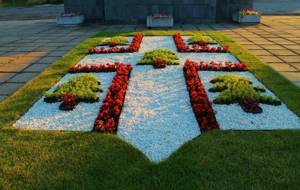
- Radiator beds are striped ribbons of flowers used to create natural contours in areas of the garden. Do-it-yourself flower beds can be combined with other decorative elements for the site, for example, stones or interesting walls and borders;
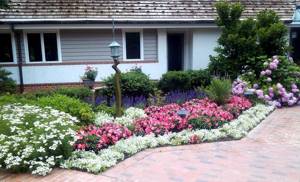
- Rows of flowers planted along paths are border-type flower beds. Simple flower rows are a ready-made way to separate a pedestrian path from the site;

- Combining different styles and designs in a flower garden at the dacha is called a mixborder. The condition for its creation is the constant flowering of the flower bed, that is, it is proposed to place annual and perennial plants with different flowering periods. The flower bed needs care, and its design plan, design and selection of flower samples need to be thought out;
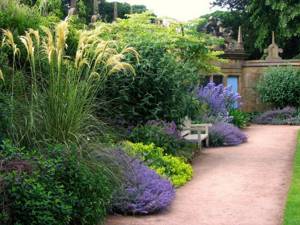
- An imitation of an alpine landscape in a dacha is achieved by arranging flowers, real and decorative stones, walls and plants according to the plan;

- Small bushes with a beautiful, interesting shape fit into the lawn. By creating such a flowerbed with your own hands, you can camouflage the bare walls of a building, a staircase or a fence wall in the yard.
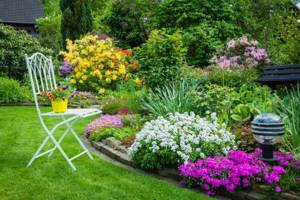
Planting beautiful perennial flowers will camouflage or highlight the retaining walls of a private home. An interesting design of retaining walls can hide both the natural slope and the overly simple design of the area. The walls of the stone building, entwined with flower vines, will become a real screen for buildings in the garden.
In mixborder
Bulbous plants will help to “color” empty spaces in the spring in a mixborder with shrubs and perennials. For this purpose, it is convenient to use small-bulbous plants, tender anemone, daffodils, tulips from the groups Triumph, Darwin hybrids, Kaufman, Greig, Foster, as well as species (they can grow in one place for several years without digging).
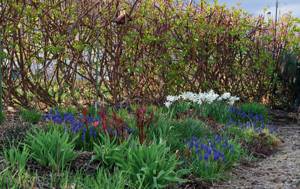
In a mixborder with flowering shrubs and perennials, bulbous plants will help color empty spaces in spring.
When the bulbous leaves begin to fade, the growing foliage of the perennials will cover them.
Flowerbed arrangement
In order for the created flowerbed at the dacha to have a beautiful appearance, when creating it you should stick to the plan and have samples of the proposed design as an example of an interesting design of the site and the walls of buildings.
Selecting a location
The location of the future flower bed is determined by three main factors - the required appearance, functionality and particular properties of the plants.
- Study the particular properties of plants and choose a beautiful place for annuals and perennials;
- Draw up a diagram of the site and buildings with a flowerbed with your own hands and see how harmoniously it fits into the landscape around a private house;
- Inspect the area of the dacha selected for placing flower beds at different times of the day. Doesn't the shadow from the wall behind a private house fall there, does the design of the flowerbed and interesting ideas for summer house design interfere with a comfortable rest.
Remember that flower perennials can grow from the center and change location and design.
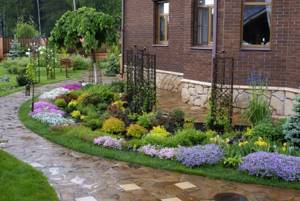
Marking
After choosing the design of the flower bed and the location of the flower bed near a private house, the boundaries are marked.
Usually they suggest using a rope and pegs, marking with stripes the layout of the flowerbed and the location of the stones. Thanks to this, you can simply prepare the soil without going beyond the territory intended for the flowers.
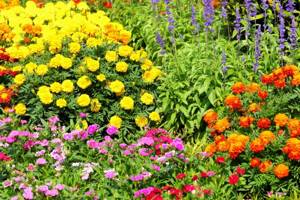
Pit preparation
The soil is dug up and pulled out. The bottom is lined with crushed stone or stone, and a drainage system is equipped using various available means. If groundwater enters, a waterproofing mat is placed before laying the drainage.
Next, fertilizers suitable for annual and perennial plants are applied, which are supplied to the flowers. After this, you add fertile soil to the flowerbed with your own hands, and you can begin planting ornamental plants and designing your dacha.

Border decoration
The final decoration of the walls of the flower bed near the house with your own hands is done by placing a stone border around the entire perimeter of the flower area. To do this, a shallow trench is dug, at the bottom of which a crushed stone bedding is laid out to prevent weeds from growing.
Instead of bricks and stones, you can use different types of improvised materials to build the wall of a flower bed. These can be decorative glass bottles, rods, wooden boards, or ready-made walls, samples of which are offered in stores.

Planting
After the final hardening of the border masonry and backfilling with black soil, about two weeks should pass. When the soil settles, it is proposed to add earth to the original level.
It is advisable to use special flower soil for planting decorative annuals and perennials.
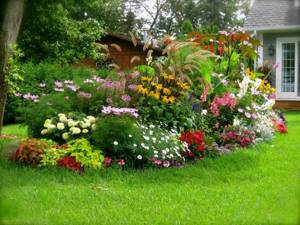
Plants are planted in the already prepared and leveled soil. How exactly to plant a particular plant depends on the flower patterns and their preferences. Remember that flowers can grow beyond the walls, and instead of a striped path or a clear center and outline, novice gardeners may end up with beds and flower beds with a decorative hodgepodge of annuals and perennials.
Patterns on the grass
You can make intricate designs from varietal daffodils on the lawn.
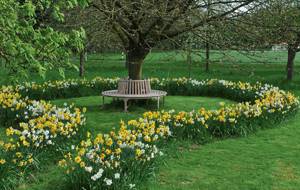
You can make intricate designs from varietal daffodils on the lawn
Important : do not mow their planting sites until the leaves have completely dried out (approximately until the end of June). You can start mowing the remaining corners of the green carpet with a clear conscience in May. This “patterned” mowing looks quite nice.
Perennials as a symbol of stability
If you don’t have time to annually change the composition of your flower beds and replant plants from place to place, it is better to stick to perennials, which, once rooted, will delight the eye for a long time. Recognized leaders among perennials are luxurious dahlias and fragrant peonies, which during their flowering turn flower beds into huge white-pink-red clouds.
Get ready for the aristocratic peony to decorate your area for 10 years or more. This dominant plant blooms vigorously throughout the summer, and the rest of the time its decorative function is performed by its dark, glossy greenery. Peonies are not capricious: in the fall it is enough to remove their above-ground part. There is no need to cover or wrap plants from frost so as not to damage the sprouts in the spring.
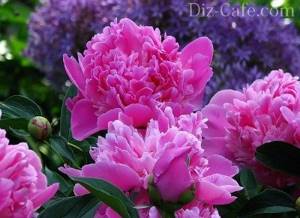
Peonies are not recommended for planting in places subject to high humidity and flooding: under the roofs of houses, under the crowns of large trees, in wetlands
Dahlias are perfect for individual plantings, for group compositions, and even for creating lush arrays. They love places that are well lit by the sun but protected from the wind. One of the conditions for planting is moisture-intensive, fairly fertile soil, as well as moderate use of organic matter (manure). Dahlias bloom towards the end of summer, so flower beds can be supplemented with shorter plants.
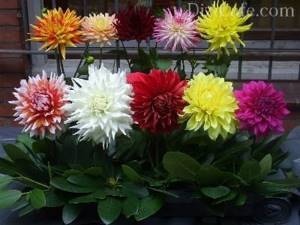
The roots of dahlias need additional air flow: by regularly feeding and watering the flowers, it is necessary to loosen the soil and remove weeds
Read more in the articles:
In the rock garden
Here the conditions are created in which many bulbous plants live in nature: rocky soil, good drainage, plenty of sun.
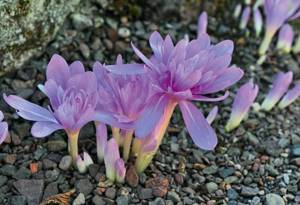
Colchicums in rockeries
Many species of tulips and their varieties will take root well in rockeries (Batalin's tulip, T. Foster's, T. pretty, T. rocky, T. Sprenger's, T. late), low onions, Chionodoxa Forbes, colchicums, crocuses, wintering spring flowers, kandyki, hazel grouse, iridodictiums, white flowers, dwarf daffodils, muscari.
Planting flowers in flowerbeds and containers
A composition of regular geometric shape - in the form of a circle, square, polygon - is usually intended for all-round viewing. Flowerbeds are placed in the front parts of the garden, for example at the entrance to the house. Therefore, it is important that they attract attention throughout the season.
For planting plants in the garden in a flower bed, preference is usually given to summer flowers that bloom from spring to autumn, sometimes changing the composition: until June 10-15, the flower garden is decorated with bulbs planted in the fall or viola, which is planted in mid-May.
These plants are not afraid of spring frosts. At the beginning of summer, cold-resistant flowers are replaced by heat-loving summer flowers, and flowering continues until autumn.
Containers are used where it is impossible to create permanent flower beds - in areas with hard surfaces, on balconies.
This is a very practical idea for planting flowers to decorate a plot, allowing you to create mobile compositions and change the appearance of the garden at the owner’s discretion. Not all plants are suitable for such plantings.
First of all, we need drought-resistant crops - the soil in a container dries out much faster than in a traditional flower garden. Plants with wide leaves that consume a lot of moisture are not suitable for such plantings. The best choice is compact plants or their varieties that have a beautiful shape—spherical, pillow-shaped, or ampelous.
As shown in the photo, when planting garden flowers in a massive container, you can place a fairly large and “ankle-legged” plant in the center, decorating its lower part with a “skirt” of lush summer flowers:
In semi-shade flower beds
Some bulbous plants can also be used in semi-shade flower beds. In such conditions, snowdrops, white flowers, goose onions, kandyks, daffodils, onions (strange, bear and victory), blueberries, checkered hazel grouse and chionodoxes and even some tulips (Delacluse and pretty varieties) will feel good.
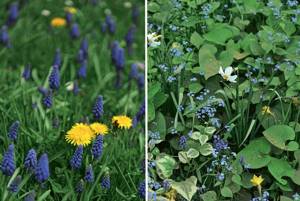
Left: Muscari on the lawn. Right: Daffodils can also be used in semi-shade flower beds
Cans

Don’t rush to throw away tin cans after cooking, because they are also suitable as plant pots. Rinse them well to remove food residues, sand the sharp edges, make holes in the bottom and degrease the surface. You can paint this material using acrylic paint or a spray can.
In the case of spraying, you will get a uniformly colored flower pot, and this way you can easily make a stencil design. More subtle patterns require drawing, so in this case you will need to work with a small brush. As an additional decoration, use a thin rope.
Decorated tin cans are perfect for decorating a garden plot, a fence, or a gazebo. Also, with a suitable color scheme and design, they can fit into a home interior in the loft and Provence styles.
On the beds
In addition to the fact that some bulbous plants are garden crops (onions, shallots, shortbread, garlic), beds with seedlings can be decorated with tulips and hyacinths. Then in the spring, when vegetables or green crops have not yet grown, the garden will not look so empty.

Beds with seedlings can be decorated with tulips and hyacinths
Creating a flower bed in Siberia
Perennials prefer temperate climates. In harsh conditions, when the ground freezes, not all species get along and eventually die. However, there are perennials that thrive in the Siberian climate.
Traditionally, three-tier flower beds are created in Siberia. This ensures a blooming garden throughout the season. The effect of continuous flowering is created due to the fact that all planted perennials begin to bloom at different times. Thus, when some have faded, others begin to bloom.

- First tier. The height of the plants is up to 30 cm. Such plants surround trees and decorate paths. They usually bloom first. Low-growing: lily of the valley, pansy, primrose.
- Second tier. Height less than 0.5 m. Medium-sized: tulip, daffodil, reticulated iris, scylla.
- Third tier. The height is more than 50 cm. These can be shrubs or single tall flowers. Tall: bedstraw, New Belgian aster, phlox.
Important! Some plants may arbitrarily occupy territories not allotted to them. To limit their growth, it is recommended to create artificial fences.
Bulbs in pots
An excellent option for “mobile” flower beds on paved areas and wooden decks. In the fall, the bulbs are planted in deep plastic containers and buried in the garden for the winter. In the spring, the containers are dug out and inserted into decorative flowerpots of suitable size. After flowering, the plastic pots are transferred to the utility part of the garden, and when the foliage finally dries, the bulbs are dug up for summer storage.
Important : in deep, wide containers you can plant several types of bulbs at once - deeper - those that bloom later, and closer to the surface - those that bloom earlier.

Left: bulbs in pots. Right: Every year, breeders develop amazing varieties of bulbous plants.
Thoughtful flower bed scheme
Work should begin with drawing up a suitable diagram. It depends on what kind of flower bed you want to get as a result. It can be a standard rectangle or circle, or it can be a complex display, for example, in the form of a butterfly, a clock or a seven-flowered flower. To do this, you can use additional parts - barrels, wheelbarrows, old boxes, or you can refuse to use them.
In any case, before you start choosing colors, create on paper (or maybe on the ground) a diagram that you will bring to life.
What flowers to choose for the garden
Perennial daylilies planted in compositions will help make the area original; besides, they bloom for quite a long time. Thanks to the variety of their color palette, you can easily choose the right shades to create a single ensemble.
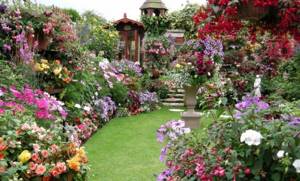
In addition, they combine well with other flowers and plants. For example, dahlias or hyacinths, phlox and tulips. Such combinations can be safely considered a win-win. But be sure to think about their location, as they can reach up to 1 m in height.
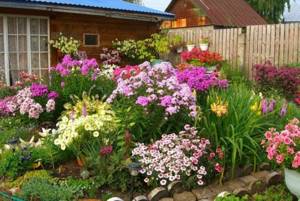
But perhaps the most beloved and sought-after country flower is petunia. It is not demanding in care, easy to plant, so even a beginner in floriculture can easily cope with it. And in order for it to bloom as early as possible, you should not plant it in the ground, it is best to use seedlings.

Bush petunia is suitable for flower beds or borders, and it is better to decorate gazebos or arches with cascading petunia, as it is unpretentious and tolerates cloudy weather well. Ampelous varieties are planted in flowerpots, their branches cascade down.

Asters, adonis, peonies, lilies, and tulips love the sun, so you need to take this into account when placing them. They are not suitable for shady places. In this case, pay attention to hydrangeas or forget-me-nots, geraniums or primroses.
Be especially careful when choosing flowers, especially if you have small children or animals in the house, because some varieties may contain toxic substances. For example, plants of the lily family have poisonous tubers.

